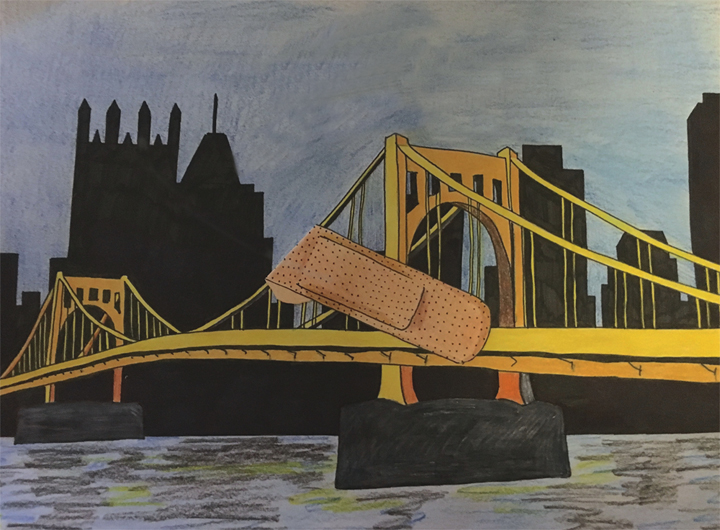Along with countless others, I drove across the Liberty Bridge on the morning of Sept. 3. Beyond the construction covering the bridge, made of steel and concrete — not especially flammable building materials — it was a normal day.
But later, a blowtorch-wielding-construction worker made a mistake. A tarp caught fire and the conflagration quickly grew out of control, according to the Pennsylvania Department of Transportation. The blaze did not melt the steel beams, but it did weaken and bend them, putting the bridge at risk of “catastrophic failure,” according to PennDOT District 11 Executive Dan Cessna. In response, the city had to shut down the bridge for 22 days.
The bridge has since reopened, to the joy of frustrated South Hills residents whose workday commutes were stymied by byzantine detours. But its long reconstruction process called attention to the horrendous state of Pittsburgh’s infrastructure. Without more resources from state lawmakers, this city’s roads and bridges will be covered in far more construction equipment and workers with concerns more consequential than a misfired torch.
In other words, if we don’t focus on greatly improving our infrastructure, we risk total collapse.
The construction workers weren’t playing with fire for fun — they were attempting to renovate the significantly deteriorated 88-year-old bridge. Before construction work had started, city officials characterized the bridge as possessing “structural deficiencies” so major that PennDOT allocated $80 million for its overhaul.
The Liberty Bridge is not alone in its need for repairs — the Greenfield Bridge gained national notoriety for its embarrassing state of decay. The bridge, which spanned the Parkway East and connected Oakland to Greenfield, started shedding concrete blocks onto the major artery below in 1989. Instead of rebuilding and rehabilitating the bridge, the city installed nets to catch the falling debris. When that ceased to be effective, a bridge underneath the bridge was constructed to protect drivers.
John Oliver rightly lampooned this absurd state of affairs on his HBO program, to the chagrin of Pittsburgh’s reputation. Thankfully, the bridge was imploded in December, 26 years after it started falling apart.
It’s great news that the Liberty and Greenfield bridges are being rebuilt, but they are just the start of the problem when it comes to our infrastructure crisis. At least 20 bridges within the city are “structurally deficient” by PennDot standards.
In 2014, Pennsylvania received a D+ grade for its bridges on its infrastructure report card, issued by the American Society of Civil Engineers.
To address this state of affairs, Harrisburg approved a $2.3 billion spending bill in 2013 specifically to improve the state’s infrastructure. According to PennDot, though, Allegheny County alone requires $1.8 billion for necessary infrastructure projects. In just one county, almost all of the bill’s funding could be sapped, leaving only $500 million for the rest of the state. According to the ASCE’s report card, it is estimated that by 2019, 40 percent of the funding needed for bridges will not be met. Clearly, Harrisburg hasn’t done, and isn’t doing, enough.
Pennsylvania is constantly strapped for cash when it comes to infrastructure spending because taxes are too low. State income taxes do not provide funding for infrastructure projects in Pennsylvania, which instead get their money from the gas tax, vehicle registration funds, driver license fees and general funds.
The average Pennsylvanian pays 60 percent less gas tax than they did in 1970 due to inflation and improved gas mileage. This may be good for our wallets, but it’s damning for our roads.
Of course, nobody likes taxes. Modern Republicans generally abhor taxes, and Democrats, despite having a more favorable view of taxes, really don’t like regressive taxes like the one on gas. It’s hard to advocate for a higher price at the pump and DMV, but that is exactly what Pennsylvania needs. Unfortunately, Pennsylvania already has the highest gas taxes in the country, as its citizens pay 68.9 cents per gallon to the state and federal government. But it is one of the few ways this state will have the necessary funds to improve our bridges, tunnels and roads.
Michael Glass, a professor of urban studies at Pitt, advocates for alternative solutions, like public-private partnerships, or P3s, where governments contract with private business for everything from infrastructural repairs to the complete operation of specific assets, such as toll roads. A notable example of this kind of project are the express lanes in the Virginia sections of the Washington Beltway, I-495. P3s are increasingly seen as the future of infrastructure development due to their cost effectiveness.
But Glass acknowledges that these kinds of projects are not perfect, as “they contribute to the further erosion of the public state.” P3s privatize public works, like roads, and it is somewhat distasteful to think of corporations turning a profit on structures built with tax dollars.
According to Glass, the nation should not just focus on the best way to jerry-rig our flimsy infrastructure to postpone its inevitable failure, but should instead build a future in which we are less reliant on these structures. He says that society has become “very complacent” about the existence of transportation links like the Liberty Bridge and we fixate on costly repairs. In his opinion, Pittsburgh “could instead focus more resources on increasing housing supply in the Downtown and Oakland core to change commuting patterns.”
It may be true that our current model of city planning is fundamentally unsustainable. Perhaps the City of Bridges has a few too many and this sort of infrastructural crisis was inevitable. In the future, we should pursue more sensible living patterns to minimize our dependence on expensive transportation links. Still, the fact of the matter is that these structures are falling apart as I write this sentence and they demand both our attention and tax dollars immediately.
Which means we’re all going to have to pitch in a little more and rethink our city’s future in the process. Pittsburghers are in for the long haul.



